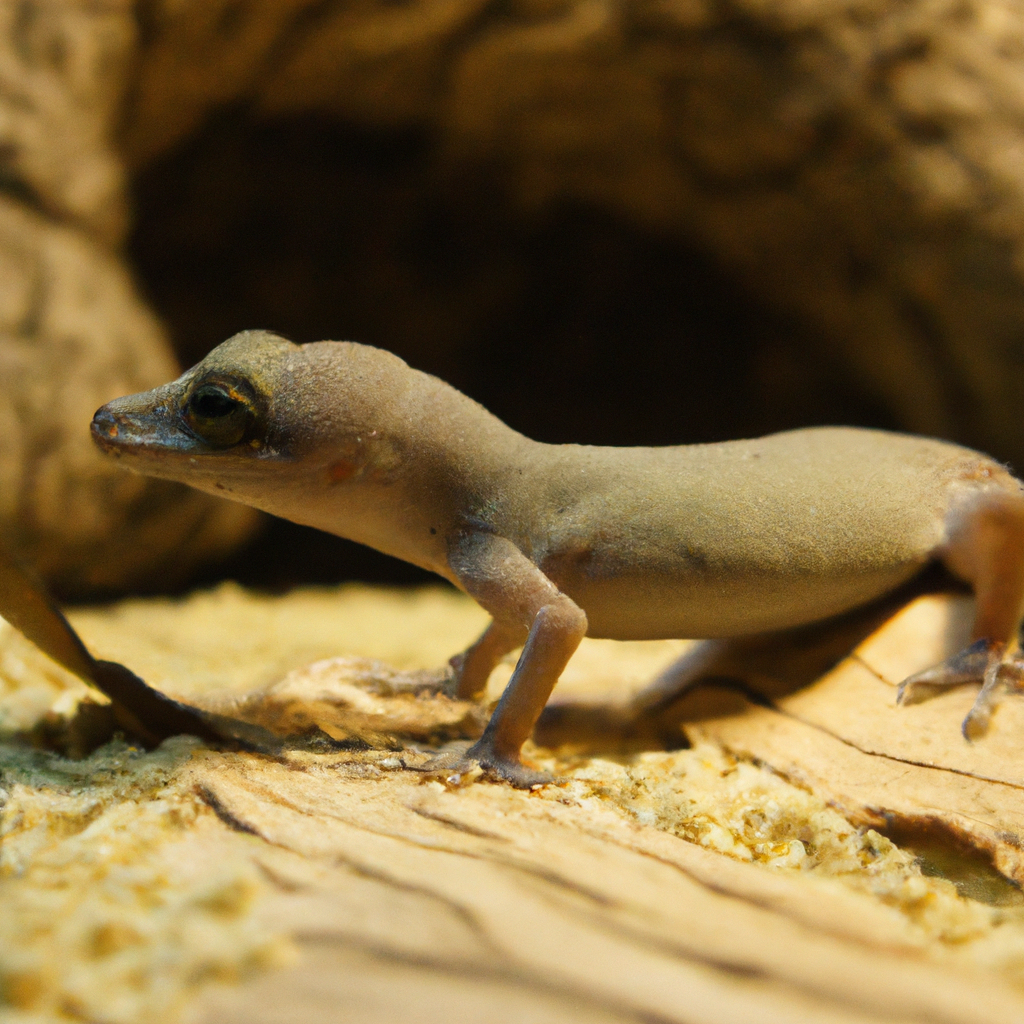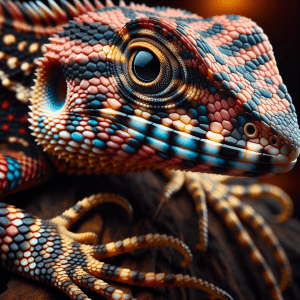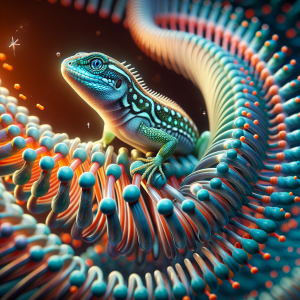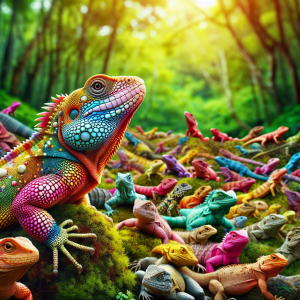Introduction to Lizard Genetics and Morphs
Lizard genetics and morphs are a fascinating aspect of the reptilian world that intrigues both scientists and reptile enthusiasts alike. Understanding the genetic makeup of different lizard species can provide valuable insights into the variations seen in their physical characteristics, such as coloration, patterns, and size.
Genetic variation plays a crucial role in determining the unique features of individual lizards within a species. Through the study of lizard genetics, researchers can uncover the underlying mechanisms that govern these variations. Genetic factors influence not only the outward appearance of lizards but also their behavior, physiology, and overall health.
By delving into the world of lizard genetics, we can gain a deeper appreciation for the diversity that exists within lizard populations. Different genetic traits are inherited and passed down through generations, contributing to the rich tapestry of morphological variations seen in lizards around the world.
Researchers and breeders often seek to understand and manipulate these genetic factors to produce desired morphs or color variations in lizards. Through selective breeding practices, they can amplify certain traits or introduce new mutations to create visually striking specimens that captivate the reptile community.
Overall, exploring lizard genetics and morphs opens up a world of discovery and wonder, shedding light on the intricate genetic processes that shape the appearance and characteristics of these fascinating creatures.
Understanding Genetic Variation in Lizard Species
Genetic variation plays a crucial role in shaping the diverse array of lizard species found in nature. Lizards exhibit a wide range of physical characteristics, from vibrant colors and intricate patterns to unique morphological features, all of which are influenced by their genetic makeup. By delving into the genetic underpinnings of these variations, researchers and enthusiasts can gain valuable insights into the fascinating world of lizard genetics and morphs.
Genetic variation in lizard species is the result of differences in their DNA sequences, which can lead to a myriad of physical traits. These variations can manifest in traits such as body size, scale patterns, coloration, and even behavior. Through genetic analysis, scientists can identify the specific genes responsible for these traits and understand how they are inherited across different lizard populations.
The study of genetic variation in lizards also provides important information about their evolutionary history and adaptation to various environments. By examining the genetic diversity within and between lizard species, researchers can uncover patterns of speciation, migration, and adaptation that have shaped the evolutionary trajectory of these fascinating reptiles.
Furthermore, understanding genetic variation in lizard species is essential for conservation efforts aimed at preserving their genetic diversity and ensuring the survival of endangered populations. By identifying and protecting genetically distinct populations, conservationists can help safeguard the future of these unique and valuable species.
In conclusion, genetic variation is a fundamental aspect of the diversity and beauty of lizard species. By studying the genetic underpinnings of their morphological traits, we can deepen our appreciation for these remarkable creatures and gain a greater understanding of the intricate mechanisms that drive evolution in the reptile world.
Factors Influencing Lizard Morphology
Genetic variation plays a crucial role in determining the diverse morphological characteristics seen in different lizard species. Lizards exhibit a wide range of physical traits, such as color patterns, scale textures, body size, and limb proportions, which are influenced by their genetic makeup. By studying genetic variation, researchers can unravel the intricate mechanisms that shape the appearance and behavior of these fascinating reptiles.
Genetic variation in lizard species can arise through a variety of processes, including natural selection, genetic drift, and gene flow. Natural selection acts on genetic variations that provide advantages in terms of survival and reproduction, leading to the prevalence of certain traits within a population. Genetic drift, on the other hand, refers to random changes in allele frequencies that can occur in small populations, potentially leading to the emergence of new traits. Gene flow, the exchange of genetic material between populations, can introduce novel variations into a gene pool, contributing to genetic diversity.
The study of genetic variation in lizards also sheds light on evolutionary relationships among different species and populations. By analyzing genetic markers, researchers can trace the evolutionary history of lizards, uncovering patterns of speciation, hybridization, and adaptation. Understanding genetic variation is essential for conserving endangered lizard species, as it provides insights into their genetic health and resilience to environmental changes.
Overall, genetic variation in lizard species is a fascinating field of study that offers valuable insights into the diversity and adaptation of these remarkable creatures. By delving into the genetic mechanisms underlying lizard morphology, researchers can deepen their appreciation for the intricate beauty of nature’s designs.
Popular Lizard Morphs in the Reptile Community
Within the reptile community, certain lizard morphs have gained significant popularity among enthusiasts and breeders. These morphs exhibit unique and visually striking characteristics that make them highly sought after in the market. Popular lizard morphs often result from specific genetic mutations that produce distinct color patterns, markings, or physical traits in the lizards.
Some commonly favored lizard morphs include albino morphs, which lack the pigmentation that gives typical lizards their coloration, resulting in a striking white or pale appearance. Another popular morph is the piebald morph, characterized by patches of white or light-colored scales amidst a darker background color, creating a visually appealing contrast. Additionally, morphs such as the leopard gecko morphs, which display vibrant and intricate patterns reminiscent of their namesake, are also highly coveted by reptile enthusiasts.
Breeding programs focused on producing and enhancing these popular morphs have led to the development of diverse color variations and patterns within specific lizard species. Breeders carefully select parent lizards with desired genetic traits to produce offspring that exhibit the desired morphs. As a result, the availability and variety of popular lizard morphs in the reptile market continue to expand, attracting collectors and hobbyists alike.
Understanding the genetics behind these popular lizard morphs is essential for breeders seeking to produce specific morphs and maintain the integrity of these unique traits. By studying the inheritance patterns and genetic mechanisms responsible for these morphs, enthusiasts can contribute to the conservation and propagation of rare and visually captivating lizard varieties within the reptile community.
Breeding Practices for Desired Morphs
Breeding Practices for Desired Morphs in lizards involve careful selection and pairing of individuals with specific genetic traits to produce offspring with desired morphological characteristics. Reptile breeders and enthusiasts often engage in selective breeding programs to create unique and visually striking lizard morphs that appeal to collectors and hobbyists.
When breeding for desired morphs, breeders must have a deep understanding of the genetic makeup of the parent lizards. By identifying and selecting for specific genes responsible for certain morphological traits, breeders can increase the likelihood of producing offspring with the desired characteristics. This process requires careful planning and record-keeping to track the inheritance patterns of different traits across generations.
In some cases, breeders may introduce genetic mutations through controlled breeding to create novel morphs that may not occur naturally in the wild. These mutations can result in unique colorations, patterns, or physical features that set the offspring apart from their parents. However, it is essential for breeders to prioritize the health and well-being of the animals throughout the breeding process.
Ethical considerations play a crucial role in breeding practices for desired morphs, as responsible breeders aim to maintain genetic diversity within lizard populations and avoid inbreeding that can lead to health issues in offspring. By adhering to best practices in reptile breeding, enthusiasts can contribute to the preservation and appreciation of the diverse morphological traits found in lizards.
Overall, breeding for desired morphs requires a combination of scientific knowledge, patience, and dedication to produce healthy and visually appealing offspring that showcase the beauty of genetic diversity in lizards.
Genetic Mutations and Color Variations in Lizards
In the world of lizards, genetic mutations play a significant role in creating unique color variations and morphs. These mutations can result in striking differences in pigmentation, patterns, and overall appearance among lizard species. Understanding how genetic mutations contribute to these variations is crucial for both breeders and researchers in the reptile community.
Genetic mutations can occur spontaneously or be intentionally bred to produce desired traits in lizards. These mutations can affect the production of pigments, leading to differences in colors such as albino, melanistic, piebald, or patternless variations. By studying these mutations, researchers can gain insights into the underlying genetic mechanisms that drive color diversity in lizards.
Color variations in lizards not only add to their aesthetic appeal but also serve important functions in their natural habitats. Certain color morphs may provide camouflage, help regulate body temperature, or even act as warning signals to predators. By studying the genetic basis of these color variations, researchers can better understand how lizards have evolved to survive and thrive in diverse environments.
In the reptile breeding community, genetic mutations that produce unique color morphs are highly sought after. Breeders carefully select individuals with specific genetic traits to produce offspring with desired color variations. Through selective breeding practices, breeders can create new and exciting morphs that appeal to collectors and enthusiasts.
Overall, genetic mutations and color variations in lizards showcase the fascinating complexity of genetics and evolution in these remarkable creatures. Studying these mutations not only enhances our understanding of lizard biology but also highlights the beauty and diversity of nature’s creations.
Importance of Genetic Diversity in Lizard Populations
Genetic diversity plays a crucial role in maintaining healthy and sustainable lizard populations. In the realm of lizard genetics and morphs, it is essential to understand the significance of genetic variation within species. A diverse gene pool increases the resilience of lizard populations to environmental changes, diseases, and other stressors.
In the wild, genetic diversity allows lizards to adapt to different habitats and ecological niches, ensuring their survival in varying conditions. By preserving a wide range of genetic traits, lizards are better equipped to evolve and thrive over time.
Conservation efforts focusing on maintaining genetic diversity in lizard populations are essential for safeguarding the long-term viability of these species. By protecting habitats, reducing threats such as habitat destruction and pollution, and implementing strategies to prevent inbreeding, conservationists can help preserve the genetic richness of lizards.
Furthermore, understanding the genetic diversity of lizards can also aid in breeding programs aimed at preserving rare or endangered morphs. By carefully managing breeding pairs to maintain genetic variation, captive populations can be sustained while minimizing the risks of inbreeding depression.
Overall, genetic diversity in lizard populations is a critical component of biodiversity conservation. By recognizing the importance of genetic variation and implementing measures to protect and promote it, we can contribute to the health and sustainability of lizard species for generations to come.
Conservation Efforts for Rare Morphs
Conservation efforts for rare morphs play a crucial role in ensuring the preservation of unique genetic traits within lizard populations. As human activities continue to impact natural habitats and ecosystems, many lizard species face threats of habitat loss, climate change, and illegal collection for the exotic pet trade. Rare morphs, which exhibit distinct genetic characteristics and physical traits, are particularly vulnerable to these threats.
To safeguard rare morphs, conservationists and reptile enthusiasts are increasingly focusing on initiatives aimed at protecting and conserving these genetically valuable individuals. One key aspect of conservation efforts for rare morphs involves habitat preservation and restoration. By conserving the natural habitats where these unique morphs reside, conservationists can help ensure the survival of these genetically distinct populations.
Additionally, breeding programs and captive breeding initiatives are being implemented to maintain and propagate rare morphs in controlled environments. These programs aim to create sustainable captive populations of rare morphs, which can serve as a genetic reservoir to prevent the loss of valuable genetic diversity in the wild.
Public education and awareness campaigns also play a vital role in conservation efforts for rare morphs. By raising awareness about the importance of preserving genetic diversity and the unique morphological traits of lizards, conservationists can garner support for conservation initiatives and promote responsible stewardship of these fascinating creatures.
Overall, conservation efforts for rare morphs are essential for maintaining the genetic integrity and biodiversity of lizard populations. By working together to protect these rare and valuable genetic variations, we can ensure a sustainable future for these remarkable reptiles.
Future Trends in Lizard Genetics Research
As research in the field of lizard genetics continues to advance, there are several exciting future trends that are shaping the direction of this scientific discipline. One key trend is the increasing use of advanced genetic sequencing technologies to unravel the intricate genetic makeup of various lizard species. By employing techniques such as whole-genome sequencing and genetic mapping, researchers can gain a deeper understanding of the genetic factors that underlie morphological traits and color variations in lizards.
Another important trend is the exploration of epigenetic mechanisms that influence gene expression and phenotype in lizards. Epigenetics plays a crucial role in regulating gene activity without altering the underlying DNA sequence, offering insights into how environmental factors can impact the expression of genes related to morphological features in lizards.
Furthermore, the integration of bioinformatics and computational biology tools is revolutionizing the analysis of large-scale genetic data in lizard research. By leveraging these tools, scientists can identify genetic markers associated with specific morphs, predict the outcomes of breeding experiments, and track the genetic diversity of lizard populations more effectively.
Additionally, the application of CRISPR-Cas9 gene editing technology in lizard genetics holds great promise for manipulating specific genes and creating targeted genetic modifications in lizards. This innovative tool opens up new possibilities for studying gene function, understanding genetic diseases, and potentially generating novel morphs in lizards through precise genetic engineering.
Overall, these future trends in lizard genetics research are paving the way for groundbreaking discoveries and insights into the genetic basis of morphological diversity in lizards, offering new avenues for conservation, breeding, and scientific exploration in the field of herpetology.
Appreciating the Beauty of Lizard Genetics and Morphs
As we delve deeper into the realm of lizard genetics and morphs, one cannot help but be captivated by the sheer beauty and complexity of these fascinating creatures. The intricate interplay between genes and environmental factors gives rise to a stunning array of morphological variations in lizard species, each more enchanting than the last.
Through careful breeding practices and selection, reptile enthusiasts have been able to create and showcase an impressive variety of morphs within the reptile community. From vibrant color patterns to unique scale textures, each morph tells a story of genetic diversity and evolutionary adaptation.
Furthermore, the study of genetic mutations in lizards has provided valuable insights into the mechanisms that drive color variations and morphological changes in these reptiles. Understanding the genetic basis of these traits not only enhances our appreciation for the natural beauty of lizards but also sheds light on the importance of genetic diversity in maintaining healthy populations.
Conservation efforts aimed at preserving rare morphs and promoting genetic diversity play a crucial role in safeguarding the future of these unique lizard populations. By raising awareness about the significance of genetic conservation, we can ensure that future generations will continue to marvel at the breathtaking diversity of lizard genetics and morphs.
In conclusion, the study of lizard genetics and morphs offers a glimpse into the intricate workings of nature’s design. By appreciating the beauty of these genetic marvels, we can gain a deeper understanding of the interconnectedness of all living organisms and the importance of preserving genetic diversity in the natural world.




